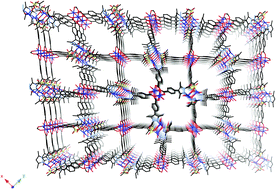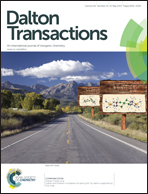The synthesis and characterisation of coordination and hydrogen-bonded networks based on 4-(3,5-dimethyl-1H-pyrazol-4-yl)benzoic acid†
Abstract
The synthesis, structural and thermal characterisation of a number of coordination complexes featuring the N,O-heteroditopic ligand 4-(3,5-dimethyl-1H-pyrazol-4-yl)benzoate, HL are reported. The reaction of H2L with cobalt(II) and nickel(II) nitrates at room temperature in basic DMF/H2O solution gave discrete mononuclear coordination complexes with the general formula {[M(HL)2(H2O)4]·2DMF} (M = Co (1), Ni (2)), whereas the reaction with zinc(II) nitrate gave [Zn(HL)2]∞, 3, a coordination polymer with distorted diamondoid topology and fourfold interpenetration. Coordination about the tetrahedral Zn(II) nodes in 3 are furnished by two pyrazolyl nitrogen atoms and two carboxylate oxygen atoms to give a mixed N2O2 donor set. Isotopological coordination polymers of zinc(II), {[Zn(HL)2]·2CH3OH·H2O}∞, 4, and cobalt(II), [Co(HL)2]∞, 5, are formed when the reactions are carried out under solvothermal conditions in methanol (80 °C) and water (180 °C), respectively. The reaction of H2L with cadmium(II) nitrate at room temperature in methanol gives {[Cd(HL)2(MeOH)2]·1.8MeOH}∞6, a 2-D (4,4)-connected coordination polymer, whereas with copper(II) the formation of green crystals that transform into purple crystals is observed. The metastable green phase [Cu3(HL)4(μ2-SO4)(H2O)3]∞, 7, crystallises with conserved binding domains of the heteroditopic ligand and contains two different metal nodes: a dicopper carboxylate paddle wheel motif, and, a dicopper unit bridged by sulfate ions and coordinated by ligand pyrazolyl nitrogen atoms. The resultant purple phase {[Cu(HL)2]·4CH3OH·H2O}∞, 8, however, has single copper ion nodes coordinated by mixed N2O2 donor sets with trans-square planar geometry and is threefold interpenetrated. The desolvation of 8 was followed by powder X-ray diffraction and single crystal X-ray diffraction which show desolvation induces the transition to a more closely packed structure while the coordination geometry about the copper ions and the network topology is retained. Powder X-ray diffraction and microanalysis were used to characterise the bulk purity of the coordination materials 1–6 and 8. The thermal characteristics of 1–2, 4–6 and 8 were studied by TG-DTA. This led to the curious observation of small exothermic events in networks 4, 6, and 8 that appear to be linked to their decomposition. In addition, the solid state structures of H2L and that of its protonated salt, H2L·HNO3, were also determined and revealed that H2L forms a 2-D hydrogen bonded polymer incorporating helical chains formed through N–H⋯O and O–H⋯N interactions, and that [H3L]NO3 forms a 1-D hydrogen-bonded polymer.


 Please wait while we load your content...
Please wait while we load your content...